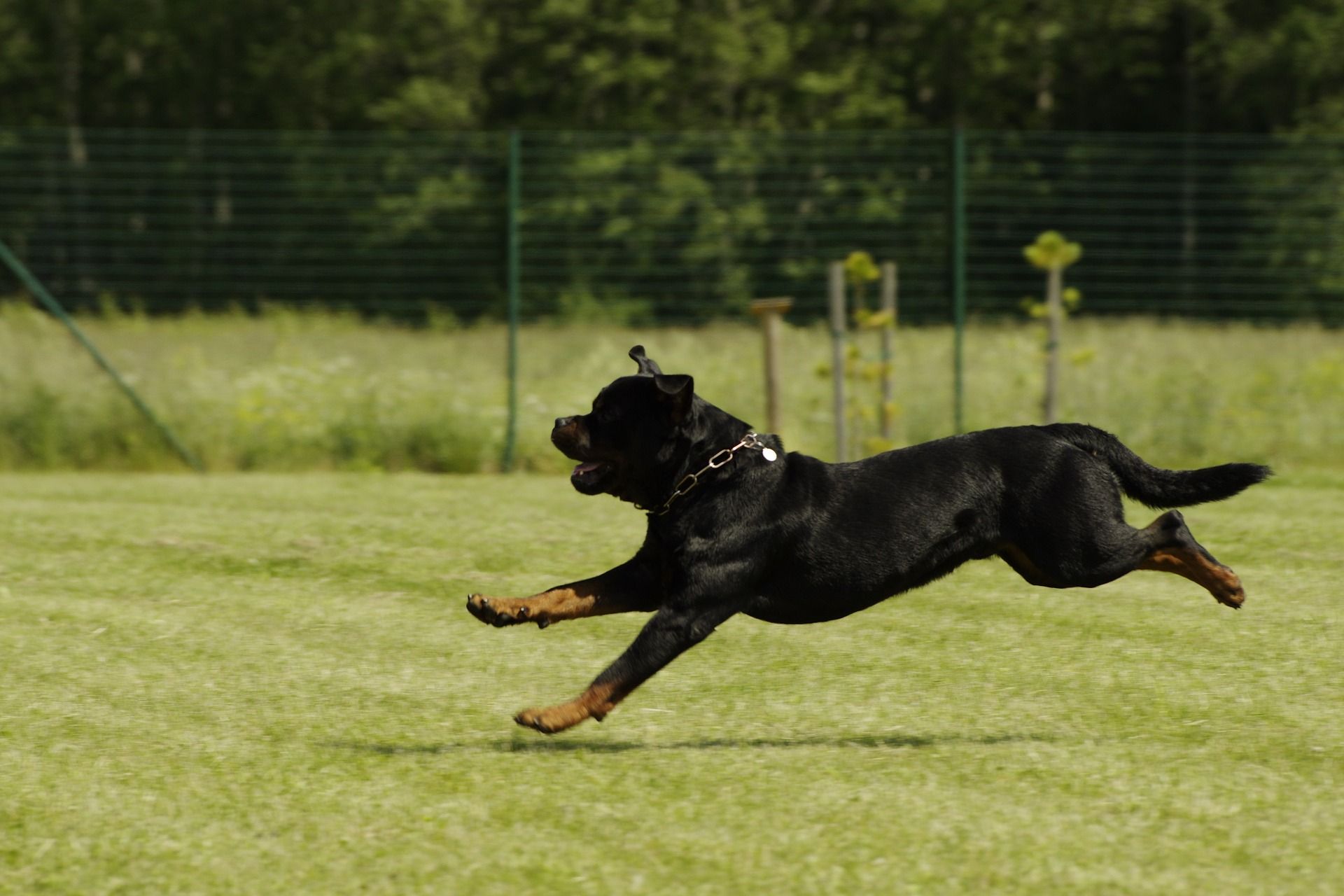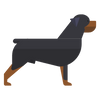Is Running Good for Rottweilers? Benefits and Dangers

Rottweilers are known as powerful dogs and are often seen running around the yard or park. Many owners therefore think that their Rottweilers would make good strong running companions. But with a known predisposition for joint problems, it's worth looking into whether or not running is actually good for your Rottweiler.
Running is good for Rottweilers because, like any exercise, it can improve their mental and cardiovascular health, increase their lifespan and prevent destructive behaviour. However, running more than 10-15 minutes at a time can lead to exhaustion, joint injuries and early-onset of joint dysplasia.
I will talk more about the benefits and dangers of running below, offering solutions to running with your Rottweiler. It may also be helpful for you to know how you can prevent running-related injuries.
Please note, some of the links on this site are affiliate links which help support the running of this site at no additional cost to you.
Is Running Good for Rottweilers?
Running in short bursts is healthy for a Rottweiler. However, long-distance running can be detrimental to their health and should be avoided. Below are both the benefits and dangers to running in a Rottweiler.
Benefits to Running
Improves Health
Running can strengthen a Rottweiler's heart, keep their mind sharp and even lengthen their lifespan. Much like humans, running will also improve their mental health, and prevent obesity, anxiety and depression.
However, keep in mind that these are all benefits your Rottweiler can get from exercise in general. Rottweilers need around two hours of exercise per day, which could include two half-hour walks and an hour or so of games (or time in the backyard). This burns off any excess energy.
They key difference with running is that you can burn this energy off a lot quicker than just walking or roaming. Instead of a 30-minute walk, they are usually tired after just 10-15 minutes of running.
Prevents Destructive Behaviour
Running will also keep your Rottweiler out of mischief. Most large dog owners realise that a dog with too much energy becomes destructive and is more difficult to control.
Again, this is something that all comes down to meeting the exercise needs of your Rottweiler. If you can dedicate more time to walking your Rottie and playing backyard games, you will still prevent this behaviour. However, if you want to tire them out quickly, running is the way to go.
In saying that, there are risks associated with running that you must keep in the back of your mind. Below are all the dangers that may make you think twice about using running as his/her primary source of exercise.
Dangers of Running
Despite the health benefits, running can actually be quite dangerous for a Rottweiler. Here are the main reasons why.
Running can Lead to Exhaustion
Rottweilers have a very muscular body and are quite heavy, weighing around 100 lbs. This means that they will tire very quickly when running, making it easy to over-exercise your Rottweiler.
If your Rottweiler runs beyond this point, it may put strain on his/her cardiovascular system and initiate the release of stress hormones. It can also have detrimental effects on metabolic and immune functions.
Predisposition for Joint Dysplasia
Rottweilers seem to be predisposed to hip and elbow dysplasia. This is a condition where the bones in that joint do not fit together perfectly, which can cause early degeneration and pain.
Running can aggravate this condition in your Rottweiler, causing them pain or discomfort. If your Rottie runs before these joints are fully formed (18-24 months of age), they may also be at higher risk of developing the condition.
Risk of Ligament Injury
Like in humans, running puts additional strain on joints in the legs when compared to walking or jogging. This is because of the shock that radiates through each leg on impact.
Putting strain on these joints increases the likelihood of ligament injuries. These injuries are not only painful and debilitating, but also very costly to repair. Obesity and age (too young or too old) can further increase this risk when running.
Preventing Running Injuries in Rottweilers
Running is a natural behaviour in dogs and you can't stop them from wanting to run. However, when a Rottweiler runs freely, they know when to slow down or stop for a rest.
It is only when Rottweilers are being forced to run that they are at greatest risk of injury. This can include running on the lead or following you as you run. Your Rottie loves you very much and will always want to please you. If you are running, they will push themselves to keep going.
Therefore, we just need to put some protective mechanisms in place to prevent running injuries in your Rottweiler. Below are practical ways you can protect your Rottie.
Look for Signs of Tiredness
- Panting heavily
- Falling behind
- Resistance on the leash
- Sitting down at every opportunity
Look for Signs of Strain
- Limping
- Guarding one leg
- Sudden yelping or whimpering
Lower the Risk
- Maintain an optimum weight (~110 lbs for males and 92 lbs for females)
- Avoid running before joints have fully matured (18-24 months)
- Delay sterilisation (click here for more information)
Limit Forced Running
- Choose to walk on a leash instead of run
- If running on a leash, choose a jogging pace instead
- Limit all running activities to 10-15 minutes
How Fast Can a Rottweiler Run?
A Rottweiler can run up to 25 mph. Considering Rottweilers aren't built for speed, this is still pretty impressive. For comparison, if you were to run for your life at top speed, you would probably be nearing 12 mph.
This is also faster than the average dog, which usually runs at around 15-20 mph. A Rottweiler's speed comes down to their powerful muscles. If it weren't for their solid physique, they would be able to run even faster.
However, Rottweilers cannot maintain these speeds for long. You can expect your Rottweiler to run at top speed for only a minute or two.
Can Rottweilers go on Runs?
Depending on your speed, your Rottweiler may only be able to go on short runs with you. Rottweilers can run much faster than us (see above) and could easily run alongside you on your daily run.
However, their weight and physique make it hard to run long-distances. At top speed (25 mph), your Rottweiler can only run for 1-2 minutes. At the average human running speed, which is 6-8 mph, a Rottweiler can last around 10-15 minutes.
With this in mind, if you want to take your Rottweiler on a longer run, you should maintain a light jog. This will ensure your Rottie doesn't become over-tired.
Keep in mind that you should not take Rottweiler puppies (under 18 months) or older Rottweilers (7+ years old) on runs. Running with puppies can cause future joint problems, and puts older dogs at higher risk of ligament injuries.
How Much Running Does a Rottweiler Need?
Rottweilers require around 2 hours of exercise per day. However, this includes a range of activities. This is because a Rottweiler can usually only run 10-15 minutes at a time before becoming tired.
As part of their 2-hour exercise regime, Rottweilers do not need to go on a dedicated run. However, it is important to give your Rottweiler the opportunity to run throughout the day. Running will help keep they cardiovascular system strong.
In saying that, as long as your Rottweiler has time to run around off-leash (even in the backyard), they should be fine with walking. It is actually better to spend more time walking with your Rottweiler because running can put strain on their joints.
Below are a number of activities that involve running that you can include in your Rottie's daily exercise regime.
Running Activities for Your Rottweiler
- Running alongside you (for no more than 10-15 minutes)
- Jogging alongside you
- Playing fetch
- Running off-leash around the park/woods
- Swimming (similar cardiovascular benefits, but good for their joints)
- Games like soccer

